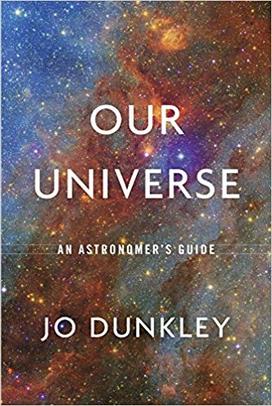Professor Jo Dunkley Explains The Universe

In Our Universe (Belknap), cosmologist Jo Dunkley clearly explains many of the big things we know about the universe, and how scientists came to discover them, from black holes, to distant galaxies, expanding space, and more. Complemented by simple, effective illustrations of complex astrophysical concepts and techniques, Our Universe is an engaging introduction to the nature of our cosmic home.

Opening Lines: On a clear night the sky above us is strikingly beautiful, filled with stars and lit by the bright and changing Moon. The darker our vantage point, the more stars come into view, numbering from the tens or hundreds into the many thousands. We can pick out the familiar patterns of the constellations and watch them slowly move through the sky as the Earth spins around. The brightest lights we can see in the night sky are planets, changing their positions night by night against the backdrop of the stars. Most of the lights look white, but with our naked eyes we can notice the reddish tint of Mars, and the red glow of stars like Betelgeuse in the Orion constellation. On the clearest nights we can see the swathe of light of the Milky Way and, from the southern hemisphere, two shimmery smudges of the Magellanic Clouds.
Beyond its aesthetic appeal, the night sky has long been a source of wonder and mystery for humans around the world, inspiring questions about what and where the planets and stars are, and how we on Earth fit into the larger picture revealed by the sky above us. Finding out the answers to those questions is the science of astronomy, one of the very oldest sciences, which has been at the heart of philosophical inquiry since ancient Greece. Meaning ‘law of the stars’, astronomy is the study of everything that lies outsides our Earth’s atmosphere, and the quest to understand why those things behave the way they do.
Humans have been practicing astronomy in some form for millennia, tracking patterns and changes in the night sky and attempting to make some sense of them. For most of human history astronomy has been limited to those objects visible to the naked eye: the Moon, the brightest planets of our Solar System, the nearby stars, and some transient objects like comets. In just the last 400 years humans have been able to use telescopes to look deeper into space, opening up our horizons to studying moons around other planets, stars far dimmer than the naked eye can see, and clouds of gas where stars are born. In the last century our horizon has moved outside our Milky Way galaxy, allowing the discovery and study of a multitude of galaxies, and find entirely new planets around other stars. In doing so, modern astronomy continues to seek solutions to the age-old questions of how we came to be here on Earth, how we fit into our larger home, what will be the fate of Earth far in the future, and whether there are other planets that could be home to other forms of life.
Reviews: “This luminous guide to the cosmos encapsulates myriad discoveries. Astrophysicist Jo Dunkley swoops from Earth to the observable limits, then explores stellar life cycles, dark matter, cosmic evolution and the soup-to-nuts history of the Universe. No less a thrill are her accounts of tenth-century Persian astronomer Abd al-Rahman al-Sufi, twentieth- and twenty-first-century researchers Subrahmanyan Chandrasekhar, Jocelyn Bell Burnell and Vera Rubin, and many more.”—Nature











No responses yet